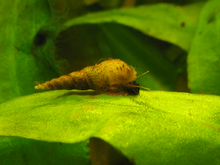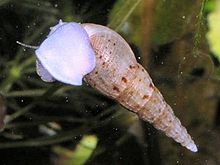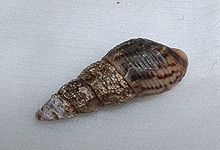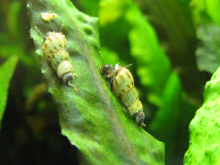- Red-rimmed melania
-
Malaysian trumpet snail 

Conservation status Scientific classification Kingdom: Animalia Phylum: Mollusca Class: Gastropoda (unranked): clade Caenogastropoda
clade SorbeoconchaSuperfamily: Cerithioidea Family: Thiaridae Genus: Melanoides Species: M. tuberculata Binomial name Melanoides tuberculata
(O. F. Müller, 1774)[2]Synonyms Nerita tuberculata[2]
Melanoides tuberculatus (O. F. Müller, 1774)The red-rimmed melania, scientific name Melanoides tuberculata,[3][4] is a species of freshwater snail with an operculum, a parthenogenetic, aquatic gastropod mollusk in the family Thiaridae.
The common name comes from the presence of reddish spots on the otherwise greenish-brown shell.[5]
It is sometimes spelled Melanoides tuberculatus, but this is incorrect because Melanoides Olivier, 1804 is feminine since it was combined with the feminine specific epithet fasciolata in the original desciption.[3][4]
Contents
Shell description
This species has an elongate, conical shell, which is usually light brown, marked with rust-colored spots.[6] An operculum is present.[6]
The average shell length is about 20–27 mm[7] or 30–36 mm, but exceptional specimens may be up to 80 mm long.[6] Shells of this species have 10–15 whorls.[7]
Distribution
This species is native to subtropical and tropical northern Africa and southern Asia.[6]
- in Africa
- Algeria, Burundi, The Democratic Republic of the Congo, Egypt, Eritrea, Ethiopia, Kenya, Libya, Malawi, Morocco, Mozambique, Namibia, Niger,[1]
- South Africa (Eastern Cape Province, Free State, Gauteng, KwaZulu-Natal, Limpopo Province)[1]
- Senegal,[8] Sudan, Swaziland, Tanzania, Tunisia, Zimbabwe.[1]
- in Asia
- Bangladesh, China, India (including Andaman Islands), Japan, Laos, Malaysia (Peninsular Malaysia), Nepal, Saudi Arabia, Sri Lanka, Vietnam[1]
- Thailand[9][1]
Prehistoric localities include Gobero in Niger in 6200–5200 BCE.[10]
Nonindigenous distribution
- Cuba[11]
- United States since 1930s[6] (see below)
- Latin America in the late 1960s[12]
- Brazil - since 1967[12] (Ilha Grande in Rio de Janeiro in southeastern Brazil since 2004)[12]
- Netherlands - before 1990[13]
- New Zealand[14]
- Venezuela
- Dominica[15]
- Trinidad
- and others
This species can also be found in artificially-heated indoor habitats, such as aquaria in greenhouses, and similar biotopes:
- Czech Republic
- Germany[16]
- Great Britain
- Slovakia - thermal brook in the wild.
- and others
Nonindigenous distribution in the United States
This species has become established outside of its natural range in large part through the activities of aquarists.[5][6] These snails were imported to the United States by the aquarium trade as early as the 1930s.[6] Established populations exist from Florida to Texas, and the species may still be expanding its range in the West and Northeast.[6]
Some of these exotic populations have become very large, with densities of 10,000 per square metre being reported from the St. Johns River in Florida.[17] In some cases red-rimmed melanias are believed to have a negative impact on native snail populations.[5]
The nonindigenous distribution includes the United States: Arizona; San Francisco Bay, California;[6] Colorado; Florida; Hawai'i; Louisiana;[6] Montana; North Carolina; Nevada; Oregon; Utah;[6] and Texas.[6] (Unconfirmed in South Dakota, Virginia, and Wyoming.)[6]
Ecology
This is primarily a burrowing species that tends to be most active at night.
Habitat
Although normally a freshwater snail, this species is very tolerant of brackish water, and has been recorded in waters with a salinity of 32.5 ppt(1,024 specific gravity salinity).
It is however a warm-climate species. It appears to prefer a temperature range of 18 to 25°C[5] or of 18 to 32°C.[6] Research has been conducted to determine the snail's lethal high water temperature, which is about 50°C (120 degrees Fahrenheit).[6] This information is helpful in the disinfection of fishing gear and research equipment, which otherwise may inadvertently spread the snails to uninfested waters.[6][18]
This species is resistant to low oxygen levels.[19]
Feeding habits
This snail feeds primarily on algae (microalgae).
Life cycle
Red-rimmed melania females are both parthenogenic and ovoviparous.[6][20] Females can be recognized by their greenish coloured gonads while males have reddish gonads. Under good conditions, females will produce fertilised eggs that are transferred to a brood pouch where they remain until they hatch (parthenogenesis and viviparity).[17] Melanoides tuberculata has 1-64 embryos in its brood pouch.[20] Snails will begin reproducing at a size as small as 5 mm[20] or 10 mm in length and broods may contain over seventy offspring (iteroparity).[5] The size of the shell of the parent at peak release of juveniles is 20.0 mm.[20] The size of juveniles at birth is 1.2-2.2 mm.[20]
Melanoides tuberculata grows to a similar size as Tarebia granifera, are similar in size at first birth and juvenile output.[20]
It is a r-strategist species.[21]
Parasites
Melanoides tuberculata is known to carry certain parasites which can be dangerous to humans. Pinto & de Melo (2011)[22] compiled checklist of 37 species of its trematode parasites.[22] Eleven of those trematodes are also parasites of human.[22] These snails serve as first intermediate host for parasites which include:[5][19]
- Clonorchis sinensis - Chinese liver fluke
- Paragonimus westermani - Oriental lung fluke[1]
- Metagonimus[1]
- Diorchitrema formosanum[1]
- Opisthorchis sinensis
- Philophthalmus sp.
- Haplorchis sp.
- Centrocestus formosanus[23]
- unknown species in Schistosomatidae[24]
This species is a host for a trematode parasite which has been found to infect an endangered species of fish in Texas, the fountain darter.[6]
Agricultural pests
Red-rimmed melanias can sometimes be an agricultural pest species, as has been reported on Chinese cabbage plantations in Hong Kong.[5]
Aquaria
Red-rimmed melanias are quite commonly found in freshwater aquaria, but opinion in the hobby is divided between those who see them as a pest species, and those who value their usefulness as algae-eaters and substrate-cleaners.[25] Among aquarists, these snails are known as Malayan livebearing snails or Malayan/Malaysian trumpet snails (often abbreviated to MTS).[17]
References
This article incorporates public domain text from references [3][6]
- ^ a b c d e f g h i Madhyastha A. (2010). Melanoides tuberculatus. In: IUCN 2010. IUCN Red List of Threatened Species. Version 2010.4. <www.iucnredlist.org>. Downloaded on 03 December 2010.
- ^ a b Müller O. F. (1774). Vermivm terrestrium et fluviatilium, seu animalium infusoriorum, helminthicorum, et testaceorum, non marinorum, succincta historia. Volumen alterum. pp. I-XXVI [= 1-36], 1-214, [1-10]. Havniæ & Lipsiæ. (Heineck & Faber). page 191.
- ^ a b c "Species summary for Melanoides tuberculata". AnimalBase, last modified 27 March 2011, accessed 19 April 2011.
- ^ a b (German) "Genus: Melanoides". Molluscs of central Europe, accessed 19 April 2011.
- ^ a b c d e f g University of Southern Mississippi/College of Marine Sciences/Gulf Coast Research Laboratory (2005-08-03). "Fact Sheet for Melanoides tuberculata (Müller, 1774)". Gulf States Marine Fisheries Commission. http://nis.gsmfc.org/nis_factsheet.php?toc_id=144. Retrieved 2007-04-08.
- ^ a b c d e f g h i j k l m n o p q r s Benson A. J. (2008). "Melanoides tuberculatus". USGS Nonindigenous Aquatic Species Database, Gainesville, FL. <http://nas.er.usgs.gov/queries/FactSheet.asp?speciesID=1037> Revision Date: 4/24/2006.
- ^ a b Glöer P. (2002). Die Süßwassergastropoden Nord- und Mitteleuropas. Die Tierwelt Deutschlands, ConchBooks, Hackenheim, 326 pp., ISBN 3-925919-60-0, page 74.
- ^ (French) Sarr A., Kinzelbach R. & Diouf M. (2011, in press). "Diversité spécifique et écologie des mollusques continenatux de la basse vallée du Ferlo (Sénégal). [Specific diversity and ecology of continental molluscs from the Lower Ferlo Valley (Senegal)]". MalaCo 7: 8 pp. PDF.
- ^ Ukong S., Krailas D., Dangprasert T. & Channgarm P. (2007). "Studies on the morphology of cercariae obtained from freshwater snails at Erawan waterfall, Erawan national park, Thailand". The Southeast Asian Journal of Tropical Medicine and Public Health 38(2): 302-312. PDF.
- ^ Sereno P. C., Garcea E. A. A., Jousse H., Stojanowski C. M., Saliège J.-F., et al. (2008). "Lakeside Cemeteries in the Sahara: 5000 Years of Holocene Population and Environmental Change". PLoS ONE 3(8): e2995. doi:10.1371/journal.pone.0002995.
- ^ Vázquez A. A. & Perera S. (2010). "Endemic Freshwater molluscs of Cuba and their conservation status". Tropical Conservation Science 3(2): 190-199. HTM, PDF.
- ^ a b c dos Santos S. B., Miyahira I. C. & de Lacerda L. E. M. (2007). "First record of Melanoides tuberculatus (Müller, 1774) and Biomphalaria tenagophila (d´Orbigny, 1835) on Ilha Grande, Rio de Janeiro, Brazil". Biota Neotropica 7(3): . doi: 10.1590/S1676-06032007000300037, HTM.
- ^ "Melanoides tuberculatus". Stichting Anemoon, accessed 27 October 2008
- ^ Duggan I. C. (2002). "First record of a wild population of the tropical snail Melanoides tuberculata in New Zealand natural waters". New Zeal. J. Mar. Fresh. Res. 36: 825-829.
- ^ Reeves W. K., Dillon Jr. R. T. & Dasch G. A. (2008). "Freshwater snails (Mollusca: Gastropoda) from the Commonwealth of Dominica with a discussion of their roles in the transmission of parasites". American Malacological Bulletin 24: 59-63. doi:10.4003/0740-2783-24.1.59. PDF.
- ^ Glöer P. & Meier-Brook C. (2003). Süsswassermollusken. DJN, pp. 134, ISBN 3-923376-02-2. page 32.
- ^ a b c Pererea G. & Walls J. G. (1996). Apple Snails in the Aquarium, pp 102-105. ISBN 0793820855.
- ^ Mitchell A., USDA-ARS, personal communication. In: Benson A. J.. (2008). Melanoides tuberculatus. USGS Nonindigenous Aquatic Species Database, Gainesville, FL. <http://nas.er.usgs.gov/queries/FactSheet.asp?speciesID=1037> Revision Date: 4/24/2006.
- ^ a b Wingard G. L., Murray J. B., Schill W. B. & Phillips E. C. (published online May 2008). "Red-rimmed melania (Melanoides tuberculatus)—A snail in Biscayne National Park, Florida—Harmful invader or just a nuisance?". U.S. Geological Survey Fact Sheet 2008–3006, 6 p. available online at http://pubs.usgs.gov/fs/2008/3006/
- ^ a b c d e f Appleton C. C., Forbes A. T.& Demetriades N. T. (2009). "The occurrence, bionomics and potential impacts of the invasive freshwater snail Tarebia granifera (Lamarck, 1822) (Gastropoda: Thiaridae) in South Africa". Zoologische Mededelingen 83. http://www.zoologischemededelingen.nl/83/nr03/a04 Table 2.
- ^ Silva E. C., Molozzi J. & Callisto M. (2010). "Size-mass relationships of Melanoides tuberculatus (Thiaridae: Gastropoda) in a eutrophic reservoir". Zoologia 27(5): 691-695. doi:10.1590/S1984-46702010000500004, PDF.
- ^ a b c Pinto H. A. & de Melo A. L. (2011). "A checklist of trematodes (Platyhelminthes) transmitted by Melanoides tuberculata (Mollusca: Thiaridae)". Zootaxa '2799: 15-28. abstract.
- ^ (Spanish) Vergara D. & Velásquez L. E. (2009). "LARVAS DE DIGENEA EN Melanoides tuberculata (GASTROPODA: THIARIDAE) EN MEDELLÍN, COLOMBIA. Larval stages of digenea from Melanoides tuberculata (Gastropoda: Thiaridae) in Medellín, Colombia". Acta Biológica Colombiana 14(1): 135-142. abstract, PDF.
- ^ Karamian M., Aldhoun J. A., Maraghi S., Hatam G., Farhangmehr B., Sadjjadi S. M. (2010). "Parasitological and molecular study of the furcocercariae from Melanoides tuberculata as a probable agent of cercarial dermatitis". Parasitology Research 108(4): 955-962. doi:10.1007/s00436-010-2138-x.
- ^ Riehl R. & Baensch H. (1996). Aquarium Atlas (vol. 1) p. 899, Voyageur Press, ISBN 3882440503.
Further reading
- Mitchella A. J. & Brandt T. M. (2005). "Temperature Tolerance of Red-Rim Melania Melanoides tuberculatus, an Exotic Aquatic Snail Established in the United States". Transactions of the American Fisheries Society 134(1): 126–131. doi:10.1577/FT03-178.1, abstract
- Bogéa T., Cordeiro F. M. & Gouveia J. S. (2005). "Melanoides tuberculatus (Gastropoda: Thiaridae) as intermediate host of Heterophyidae (Trematoda: Digenea) in Rio de Janeiro metropolitan area, Brazil". Revista do Instituto de Medicina Tropical de São Paulo 47(2): 87-90. PubMed. doi:10.1590/S0036-46652005000200005.
interactions with Biomphalaria glabrata:
- Pointier J. P. (1993). "The introduction of Melanoides tuberculata (Mollusca: Thiaridae) to the island of Saint Lucia (West Indies) and its role in the decline of Biomphalaria glabrata, the snail intermediate host of Schistosoma mansoni''. Acta Trop. 54:13-18.
- Giovanelli A., Vieira M. V. & da Silva C. L. P. A. C. (2002) "Interaction between the Intermediate Host of Schistosomiasis in Brazil Biomphalaria glabrata (Planorbidae) and a Possible Competitor Melanoides tuberculata (Thiaridae): I. Laboratory Experiments." Memórias do Instituto Oswaldo Cruz 97(3): 363-369. PDF
- Giovanelli A., Vieira M. V. & da Silva C. L. P. A. C. (2005) "Interaction Between The Intermediate Host Of Schistosomiasis In Brazil, Biomphalaria Glabrata (Say, 1818) And A Possible Competitor, Melanoides Tuberculata (Müller, 1774): A Field Study." Journal of Molluscan Studies 71(1): 7-13. doi:10.1093/mollus/eyi004, abstract
External links
Categories:- IUCN Red List least concern species
- Thiaridae
- Fishkeeping
- Invasive animal species
Wikimedia Foundation. 2010.




